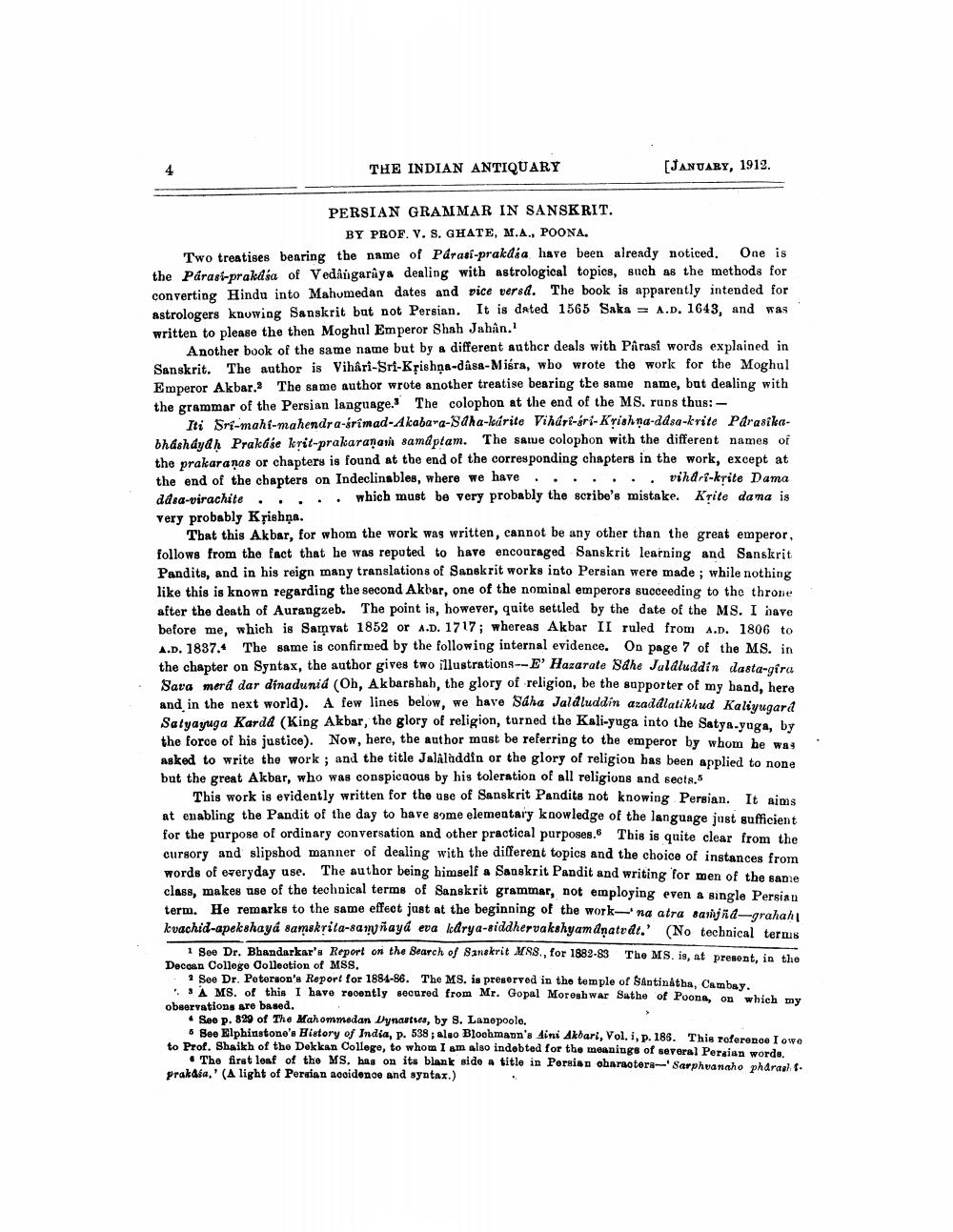Book Title: Indian Antiquary Vol 41 Author(s): Richard Carnac Temple, Devadatta Ramkrishna Bhandarkar Publisher: Swati Publications View full book textPage 8
________________ THE INDIAN ANTIQUARY [JANUARY, 1912. PERSIAN GRAMMAR IN SANSKRIT. BY PROF. V. S. GHATE, M.A., POONA. Two treatises bearing the name of Parasi-prakdía have been already noticed. One is the Parasi-praksa of Vedangaraya dealing with astrological topics, such as the methods for converting Hindu into Mahumedan dates and vice versa. The book is apparently intended for astrologers knowing Sanskrit but not Persian. It is dated 1565 Saka = A.D. 1643, and was written to please the then Moghul Emperor Shah Jahan. Another book of the same name but by a different auther deals with Parasi words explained in Sanskrit. The author is Vihari-Sri-Kpishņa-dâsa-Miéra, who wrote the work for the Moghul Emperor Akbar. The same author wrote another treatise bearing the same name, but dealing with the grammar of the Persian language. The colophon at the end of the MS. runs thus: Iti Sri-mahi-mahendra-srimad- Akabara-Saha-kúrite Viharf-sri-Krishna-ddsa-krite parasikabhash dyah Prakúse krit-prakarana samaptam. The same colophon with the different names of the prakaranas or chapters is found at the end of the corresponding chapters in the work, except at the end of the chapters on Indeclinables, where we have ......vihd-i-krite Dama ddsa-virachite ..... which must be very probably the scribe's mistake. Krito dama is very probably Krishna. That this Akbar, for whom the work was written, cannot be any other than the great emperor, follows from the fact that he was reputed to have encouraged Sanskrit learning and Sanskrit Pandits, and in his reign many translations of Sanskrit works into Persian were made ; while nothing like this is known regarding the second Akbar, one of the nominal emperors succeeding to the throne after the death of Aurangzeb. The point is, however, quite settled by the date of the MS. I have before me. which is Samvat 1852 or A.D. 1717; whereas Akbar II ruled from A.D. 1806 to A.D. 1837. The same is confirmed by the following internal evidence. On page 7 of the MS. in the chapter on Syntax, the author gives two illustrations--E' Hazarate Sahe Jalaluddin dasta-gira Sava merd dar dinadunid (Oh, Akbarshah, the glory of religion, be the supporter of my hand, here and in the next world). A few lines below, we have Sdha Jalaluddin azadálatikhud Kaliyugard Satyayuga Karda (King Akbar, the glory of religion, turned the Kali-yuga into the Satya-yoga, by the force of his justice). Now, here, the author must be referring to the emperor by whom he was asked to write the work, and the title Jalaluddin or the glory of religion has been applied to none but the great Akbar, who was conspicuous by his toleration of all religions and sects. This work is evidently written for the use of Sanskrit Pandits not knowing Persian. It aims at enabling the Pandit of the day to have some elementary knowledge of the language inst sufficient for the purpose of ordinary conversation and other practical purposes. This is quite clear from the cursory and slipshod manner of dealing with the different topics and the choice of instances from words of everyday use. The author being himself a Sanskrit Pandit and writing for men of the same class, makes use of the technical terms of Sanskrit grammar, not employing even a single Persian term. He remarks to the same effect just at the beginning of the work na atra sasijnd-grahah kvachid-apekshayá samskrita-8a m ayd eva kedry a-siddhervakshyam anato dt.' (No technical terms 1 See Dr. Bhandarkar's Report on the search of Sanskrit MRS., for 1882-83 The MS. is, at present, in the Decoan College Collection of MSS. Soo Dr. Peterson's Report for 1884-86. The MS. is preserved in the temple of Santinátha, Cambay. MS. of this I have rooontly soured from Mr. Gopal Moroshwar Sathe of Poona, on which my observations are based. • See p. 829 of The Mahommedan Dynasties, by S. Lanepoolo. Seo Elphinstone's History of India, p. 538 ; algo Bloohmann's Aini Akbart, Vol. 1, p. 185. This roference I owe to Prol Sheikh of the Dekkan College, to whom I am also indebted for the meanings of several Persian words. • The first loaf of the MS. has on its blank sido title in Persian characters-Sarphvancho phdraal. prakda.' (A light of Persian accidence and syntax.)Page Navigation
1 ... 6 7 8 9 10 11 12 13 14 15 16 17 18 19 20 21 22 23 24 25 26 27 28 29 30 31 32 33 34 35 36 37 38 39 40 41 42 43 44 45 46 47 48 49 50 51 52 53 54 55 56 57 58 59 60 61 62 63 64 65 66 67 68 69 70 71 72 73 74 75 76 77 78 79 80 81 82 ... 320
